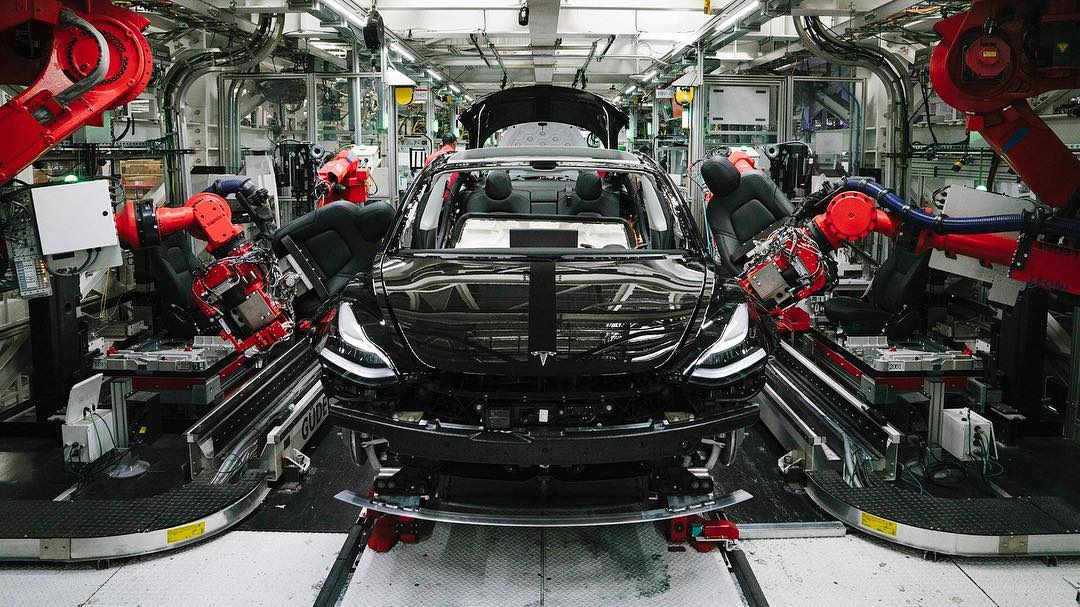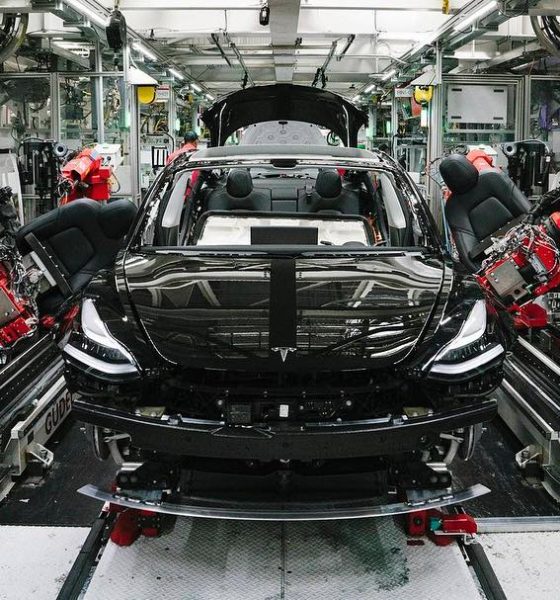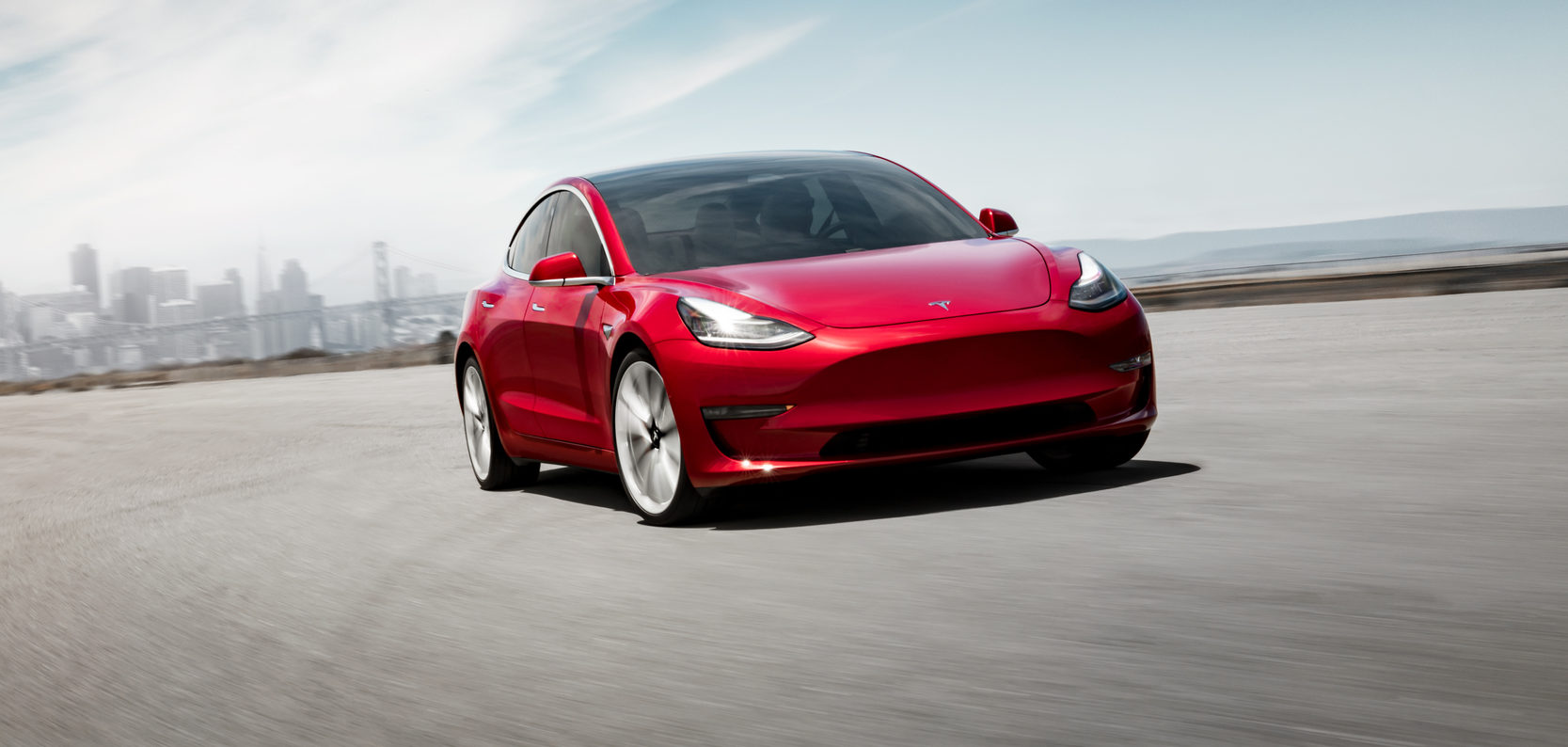

Investor's Corner
Tesla registers 13.6k new Mid Range Model 3 VINs after posting blockbuster earnings
After posting blockbuster quarterly results that pleasantly surprised Wall Street on Wednesday, Tesla has shown renewed signs that its Model 3 production ramp is gaining strength. On early Thursday, Tesla registered its largest single batch of Model 3 VINs yet, comprised of 13,629 vehicles, all of which are estimated to be RWD.
With this latest filing, Tesla had registered a total of 169,791 Model 3 to date. The absence of AWD VINs also bodes well for the demand for the Model 3’s newest variant — the Mid Range Model 3 — which utilizes a single motor at the rear, and costs less than the Long Range RWD Model 3, which starts at 49,000 before incentives.
#Tesla registered 13,629 new #Model3 VINs. ~0% estimated to be dual motor. Highest VIN is 169791. https://t.co/CbAbsrLRkz
— Model 3 VINs (@Model3VINs) October 25, 2018
The arrival of the Mid Range Model 3 came as a surprise for the vehicle’s reservation holders, particularly since the variant has not been announced prior to its launch. When the Model 3 was unveiled, Tesla had listed two RWD variants of the vehicle — a 220-mile Standard range version that starts at $35,000 and a 310-mile Long Range variant that starts at $49,000. The Mid Range Model 3, which has a range of 260 miles per charge, cost $45,000 when it was unveiled, though the price of the electric sedan was raised to $46,000 earlier this week.
The Mid Range Model 3 appears to be Tesla’s way of offering a lower-cost option for reservation holders who are holding out for the release of the $35,000 base Model 3. After the $7,500 tax credit and estimated gas savings, after all, the Mid Range Model 3’s cost of ownership falls to around $33,200. Elon Musk referenced the newly-announced Model 3 variant in the recently-held earnings call.
“We’re trying to provide (the) most affordable electric car options that we can. And so as we can — we just don’t have the ability to get to the $35,000 car right away. We thought this might be a way to offer it as an intermediate step. And that’s really it,” Musk said.
Considering the new wave of RWD VIN registrations, as well as the vehicle’s $1,000 price increase just days after it was released, it appears that the demand for the Mid Range Model 3 is quite notable. Since Elon Musk announced the car on Twitter, for one, Tesla had registered more than 18,000 RWD Model 3 VINs. Considering that the Long Range RWD variant is only available off-menu for now, it seems safe to infer that the majority of the vehicles corresponding to Tesla’s new VIN filings are Mid Range Model 3s.
The Tesla Model 3. [Credit: Tesla]
While Tesla delivered a blockbuster third quarter, the company’s fourth-quarter performance seems poised to be even more impressive. This Q4, Gigafactory 1 is expected to receive upgrades in the form of new Grohmann Machines that would make battery pack production cheaper and faster, as well as upgraded battery cell production lines from Panasonic. In terms of VIN registrations, October seems poised to set records for the company, with Tesla registering more than 51,000 VINs since the month began.
What is even more impressive is that Tesla is only partly done with its Model 3 production ramp, considering that the company is aiming to hit a production rate of 10,000 units of the electric car per week. Elon Musk proved optimistic about the ongoing ramp for the vehicle, though, as shown in his statements during the recent earnings call.
“Yeah, very minimal to get (Model 3 production) to 7,000 a week. And then I mean that’s really just basically solving improving our time of the existing lines, and we can do 7,000 a week. So and then it gets a little harder as you start to go above 7,000, it would need — at least bringing lines down in Fremont for significant upgrades to get to 10k,” Musk said.

Investor's Corner
Tesla stock closes at all-time high on heels of Robotaxi progress

Tesla stock (NASDAQ: TSLA) closed at an all-time high on Tuesday, jumping over 3 percent during the day and finishing at $489.88.
The price beats the previous record close, which was $479.86.
Shares have had a crazy year, dipping more than 40 percent from the start of the year. The stock then started to recover once again around late April, when its price started to climb back up from the low $200 level.
This week, Tesla started to climb toward its highest levels ever, as it was revealed on Sunday that the company was testing driverless Robotaxis in Austin. The spike in value pushed the company’s valuation to $1.63 trillion.
Tesla Robotaxi goes driverless as Musk confirms Safety Monitor removal testing
It is the seventh-most valuable company on the market currently, trailing Nvidia, Apple, Alphabet (Google), Microsoft, Amazon, and Meta.
Shares closed up $14.57 today, up over 3 percent.
The stock has gone through a lot this year, as previously mentioned. Shares tumbled in Q1 due to CEO Elon Musk’s involvement with the Department of Government Efficiency (DOGE), which pulled his attention away from his companies and left a major overhang on their valuations.
However, things started to rebound halfway through the year, and as the government started to phase out the $7,500 tax credit, demand spiked as consumers tried to take advantage of it.
Q3 deliveries were the highest in company history, and Tesla responded to the loss of the tax credit with the launch of the Model 3 and Model Y Standard.
Additionally, analysts have announced high expectations this week for the company on Wall Street as Robotaxi continues to be the focus. With autonomy within Tesla’s sights, things are moving in the direction of Robotaxi being a major catalyst for growth on the Street in the coming year.
Elon Musk
Tesla needs to come through on this one Robotaxi metric, analyst says
“We think the key focus from here will be how fast Tesla can scale driverless operations (including if Tesla’s approach to software/hardware allows it to scale significantly faster than competitors, as the company has argued), and on profitability.”

Tesla needs to come through on this one Robotaxi metric, Mark Delaney of Goldman Sachs says.
Tesla is in the process of rolling out its Robotaxi platform to areas outside of Austin and the California Bay Area. It has plans to launch in five additional cities, including Houston, Dallas, Miami, Las Vegas, and Phoenix.
However, the company’s expansion is not what the focus needs to be, according to Delaney. It’s the speed of deployment.
The analyst said:
“We think the key focus from here will be how fast Tesla can scale driverless operations (including if Tesla’s approach to software/hardware allows it to scale significantly faster than competitors, as the company has argued), and on profitability.”
Profitability will come as the Robotaxi fleet expands. Making that money will be dependent on when Tesla can initiate rides in more areas, giving more customers access to the program.
There are some additional things that the company needs to make happen ahead of the major Robotaxi expansion, one of those things is launching driverless rides in Austin, the first city in which it launched the program.
This week, Tesla started testing driverless Robotaxi rides in Austin, as two different Model Y units were spotted with no occupants, a huge step in the company’s plans for the ride-sharing platform.
Tesla Robotaxi goes driverless as Musk confirms Safety Monitor removal testing
CEO Elon Musk has been hoping to remove Safety Monitors from Robotaxis in Austin for several months, first mentioning the plan to have them out by the end of 2025 in September. He confirmed on Sunday that Tesla had officially removed vehicle occupants and started testing truly unsupervised rides.
Although Safety Monitors in Austin have been sitting in the passenger’s seat, they have still had the ability to override things in case of an emergency. After all, the ultimate goal was safety and avoiding any accidents or injuries.
Goldman Sachs reiterated its ‘Neutral’ rating and its $400 price target. Delaney said, “Tesla is making progress with its autonomous technology,” and recent developments make it evident that this is true.
Investor's Corner
Tesla gets bold Robotaxi prediction from Wall Street firm
Last week, Andrew Percoco took over Tesla analysis for Morgan Stanley from Adam Jonas, who covered the stock for years. Percoco seems to be less optimistic and bullish on Tesla shares, while still being fair and balanced in his analysis.

Tesla (NASDAQ: TSLA) received a bold Robotaxi prediction from Morgan Stanley, which anticipates a dramatic increase in the size of the company’s autonomous ride-hailing suite in the coming years.
Last week, Andrew Percoco took over Tesla analysis for Morgan Stanley from Adam Jonas, who covered the stock for years. Percoco seems to be less optimistic and bullish on Tesla shares, while still being fair and balanced in his analysis.
Percoco dug into the Robotaxi fleet and its expansion in the coming years in his latest note, released on Tuesday. The firm expects Tesla to increase the Robotaxi fleet size to 1,000 vehicles in 2026. However, that’s small-scale compared to what they expect from Tesla in a decade.
Tesla expands Robotaxi app access once again, this time on a global scale
By 2035, Morgan Stanley believes there will be one million Robotaxis on the road across multiple cities, a major jump and a considerable fleet size. We assume this means the fleet of vehicles Tesla will operate internally, and not including passenger-owned vehicles that could be added through software updates.
He also listed three specific catalysts that investors should pay attention to, as these will represent the company being on track to achieve its Robotaxi dreams:
- Opening Robotaxi to the public without a Safety Monitor. Timing is unclear, but it appears that Tesla is getting closer by the day.
- Improvement in safety metrics without the Safety Monitor. Tesla’s ability to improve its safety metrics as it scales miles driven without the Safety Monitor is imperative as it looks to scale in new states and cities in 2026.
- Cybercab start of production, targeted for April 2026. Tesla’s Cybercab is a purpose-built vehicle (no steering wheel or pedals, only two seats) that is expected to be produced through its state-of-the-art unboxed manufacturing process, offering further cost reductions and thus accelerating adoption over time.
Robotaxi stands to be one of Tesla’s most significant revenue contributors, especially as the company plans to continue expanding its ride-hailing service across the world in the coming years.
Its current deployment strategy is controlled and conservative to avoid any drastic and potentially program-ruining incidents.
So far, the program, which is active in Austin and the California Bay Area, has been widely successful.








